Team OKRs (Objectives and Key Results) are goals that define and drive the purpose of individual team members in alignment with the Company’s Objective. Launching team OKRs begins with the team identifying improvement or problem areas, ways to address them, and how they can make impactful changes collectively.
Every week team members can set new plans to drive improvements and have bi-weekly check-in meetings to assess progress made on those plans. By creating a quarterly Objective, setting Key Results, creating Initiatives, and aligning OKRs with the company’s goal, teams can work together to drive desired outcomes.
👉 Give teams ownership of the company’s KRs and synchronize their efforts toward achieving the overarching goal. To get started refer to this playlist of OKR examples for different teams.
Be mindful that while setting personal objectives can be done, setting OKRs for individuals does not provide business value. Setting task-based goals result in small changes that invariably do not have a big impact on the higher aspirations of the company.
Instead, collaborating to create ideas together can give meaning and purpose to daily tasks and motivate team members to focus on goals that drive the business forward.
The 5-Step Process & Benefits
“How do you write good OKRs?” That’s a common question most teams have when adopting the OKR framework. To create effective team OKRs, follow the 5 step process below:
- Step 1: Team Discussion
- Step 2: Writing an Objective
- Step 3: Writing Key Results
- Step 4: Writing Initiatives
- Step 5: Alignment & Linking
Read on to learn how this process benefits makes teams getting started with writing OKRs.
- Make Team OKRs More Motivating
By discussing and sharing feedback about OKRs, every team member can be involved and engaged. This not only motivates them it can also drive a growth mindset resulting in more impactful initiatives. Moreover, addressing challenges and celebrating wins together as a team can be more rewarding than restricting progress through a myopic view of individual goals.
- Drive Bigger Change Collaboratively
Drafting, linking, and aligning the Objectives, Key Results, and Initiatives of the team with the Company’s goal can have a bigger business impact. Instead of expecting individuals to drive big change, adopting a process of regular ideation and assessment of objectives and key results can drive more effective outcomes.
- Promote Team Cooperation and Synergy
Whether it is cohesion within a team or between teams, OKRs can help to bring everyone together to address challenges. The process of drafting OKRs, if adopted correctly, can provide a collaborative approach to addressing problems, produce better solutions, and remove personal competitiveness that can divide teams.
- Create Long-Lasting, Faster Results
By regularly meeting and checking in on the progress made, team OKRs can improve the business function as a whole. With continuous tracking, measuring, and feedback loop, improvements can be made faster and effective results can be derived sooner.
Let’s move on to the details on writing OKRs with 4 different teams. Use these real-world examples as you begin the OKR process in your company.
Finance
Break down the 5 steps for writing good OKRs in a Finance team. With real-world examples from our OKR experts.
Sales
Break down the 5 steps for writing good OKRs in a Finance team. With real-world examples from our OKR experts.
Marketing
Break down the 5 steps for writing good OKRs in a Finance team. With real-world examples from our OKR experts.
Human Resources
Break down the 5 steps for writing good OKRs in a Finance team. With real-world examples from our OKR experts.
Writing Finance OKRs
Finance teams often struggle to implement OKRs due to a lot of business-as-usual responsibilities. They need to take care of many operational tasks before they can dedicate their time to improvements.
It doesn’t mean, however, that finance teams shouldn’t have OKRs. Improvement work is extremely important, and if you don’t find the time for it, your business will suffer the consequences.
Let’s explore an OKR example for the finance team where company A has an overarching Objective “Improve cross-team collaboration”.
Step 1: Team Discussion
What should the finance department focus on to help the company achieve cross-team collaboration?
In order to determine the answer to that question, the team has to put their heads together and have a discussion that could go like this:
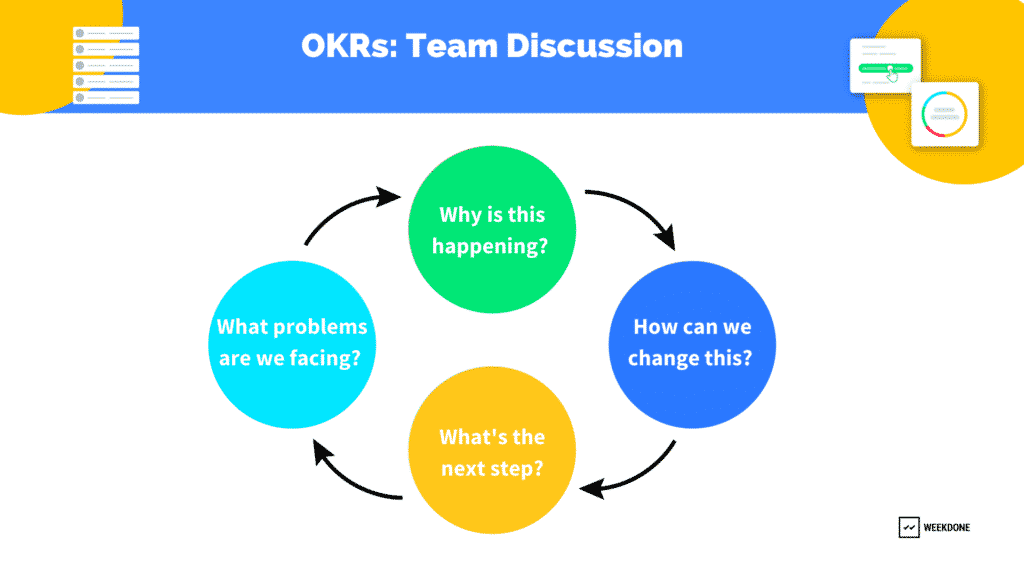
What problems are we facing?
We have a lot of overdue payments (causing contractual penalties) and late financial reports although we are always busy and always in a rush.
Why is this happening?
Answer 1: Team managers are not sending primary documentation (receipts, bills, invoices) to us on time and submit their payment requests too close to the payment deadline causing issues with unexpected fines and going over the planned budget.
Answer 2: Also, it takes a very long time for us to determine a type of expense to enter it correctly into the ERP system. The reason is a non-descriptive expense name in the invoices. If team managers specify what the payment is actually for, it will save a lot of time for us in preparing reports.
Answer 3: According to feedback from team managers, the payment request application is too complicated, as there are too many people who need to confirm the application before it comes to the finance department.
How can we change this?
Answer 1: We need to explain how financial reporting should work to reduce overhead for the team managers and make sure that we can process all documents on time.
Answer 2: We should create a straightforward manual to categorize all invoices by the type of expenses they represent. This way, when team managers submit payment requests, they can specify the expense type for us, and we wouldn’t need to spend extra time researching the background of every single document.
Answer 3: We should organize a payment confirmation process that requires no more than 3 parties involved.
So, in the team discussion, it became obvious that team managers are struggling when submitting payment requests to the financial department, and it’s not clear to them how invoices and receipts should be handled.
This is causing issues with outstanding payments being delayed, and one way to change the situation is to improve the procedure that team managers are following to submit their payment requests.
Step 2: Writing an Objective
Based on this step-by-step finance team performance analysis and the answers that the team has discovered, they can write an Objective that would focus on solving the problem:
Objective: Simplify internal procedures and make financial reporting more transparent
This Objective directly contributes to the overarching company goal (“improve cross-team collaboration“) because achieving it should mean a huge improvement in the internal processes and mutual understanding.
But how will the team know if the Objective is achieved?
In other words, what needs to change specifically so that everyone would agree that the internal procedures are simplified and financial reporting is finally more transparent?
With these two questions, the team should approach writing the Key Results for their Objective.
Step 3: Writing Key Results
First of all, the team has discovered that it takes a very long time for them to determine a type of expense to enter it correctly into the system. Often they need to check if the contractor is already in the system, and reach out to the team managers to ask what kind of service the third party has provided. This is why they are always swamped with tons of documents to process. All due to a non-descriptive expense name in the invoices. If team managers specify what the payment is for and if there was a prior purchase from this contractor, it would save a lot of time for the financial department.
Key Result 1
The go-to solution would be to categorize expenses in the payment request so that team managers could provide all of the necessary information from the beginning. So the first Key Result must indicate the change in categorizing expenses as a part of the new payment request procedure:
>80% of invoices are categorized by expense type before they come to the finance department
This would mean that the finance department needs to create a list of expense types, categorize them, and explain the new payment request form to the team managers. And only if the team managers understand and adopt the new process, this Key Result could be achieved.
Key Result 2
Secondly, the finance team needs to make sure that team managers are capable of delivering primary documentation on time. Here’s how to measure this change:
Reduce the number of primary documentation reported late to the financial department by 20%
To move the needle on this Key Result, the team might create a presentation about handling receipts, bills, invoices, and similar forms of primary documentation, to make sure that everyone else understands the process.
Only if everyone understands the process, the team would consider that they have achieved a new level of transparency in the organization. It could be even a good idea to create a leaderboard for team managers who bring documents on time!
Key Result 3
Third of all, the finance team would want to focus on making the payment confirmation process easier so that applications can reach the finance department faster from the moment when team managers submit them.
But making the process easier might not be the only issue that needs to be solved to improve the processing time. Even if you are confident in the solution, don’t assume that it’s the best one. There might be better ways to solve the problem or there might be other factors you haven’t considered. What if the procedure is simplified but the processing time hasn’t changed?
Treat your solution as a hypothesis, and keep in mind that it’s absolutely important to determine the real change the team wants to see in the future, and not just the first good hypothesis that comes to mind.
In our current example, the problem is that the payment confirmation process needs to go faster (from making a request to making the transaction). Making the payment confirmation process easier is one possible solution. But if fixing the application procedure does not solve the problem, the team will have to keep thinking about other solutions.
💡Pro Tip: Focusing on outcomes (as opposed to to-do lists) is a productivity life-hack and the greatest advantage of the OKR methodology.
So here is a measurable outcome the finance team would need to deliver:
Speed up payment processing time from “application” to “paid” from 16h to 8h
Step 4: Writing Initiatives
With the Key Results set, the finance team can now brainstorm possible Initiatives that will move the needle on the OKRs:
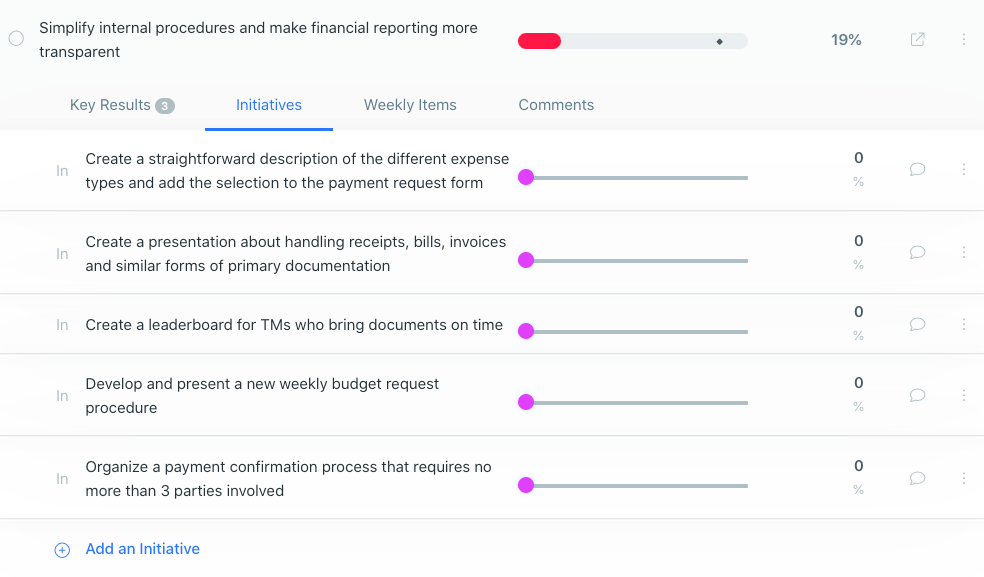
- Create a straightforward description of the different expense types and add the selection to the payment request form
- Create a presentation about handling receipts, bills, invoices and similar forms of primary documentation
- Create a leaderboard for TMs who bring documents on time
- Develop and present a new weekly budget request procedure
- Organize a payment confirmation process that requires no more than 3 parties involved
Step 5: Alignment & Linking
When the team OKR is agreed upon, drafted, and aligned with the company Objective, here is what finance OKR example looks like:
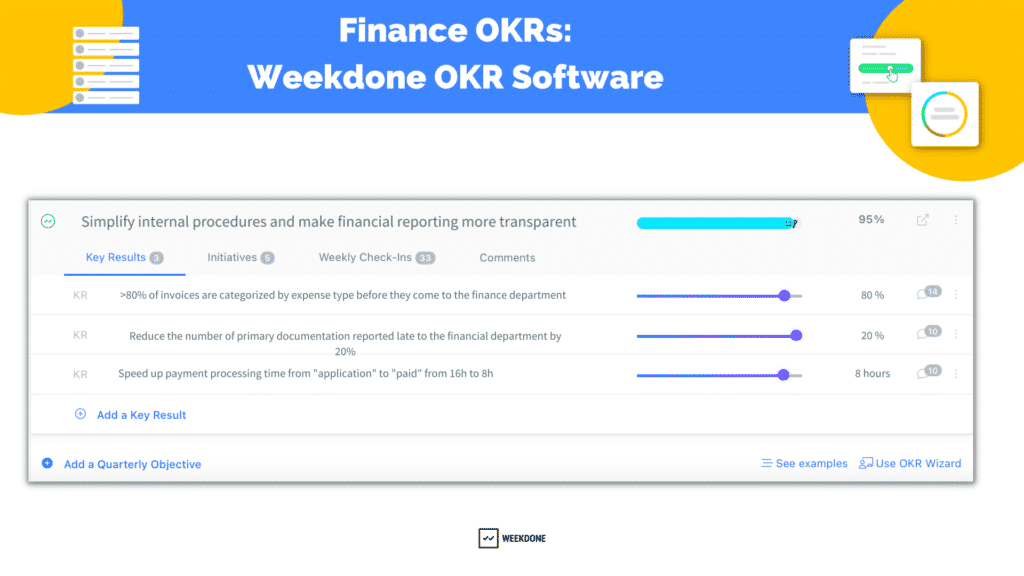
Invite your teams and start your company trial today – 14 days free for unlimited users.
Writing HR OKRs
Improving employee engagement and organizing internal workflows better are the two most popular Objectives in HR & People Management teams.
Cultural changes are hard to measure but we always know when there are internal tensions or inefficient processes. So the struggle is real, and the change for the better would be clearly noticeable.
But how do you reasonably measure the trust level among employees?
Step 1: Team Discussion
Let’s imagine that you run an HR team in a company with a lot of issues in cross-functional communication.
People don’t seem to know how to work together effectively and they tend to avoid team meetings and don’t ever take a proactive approach to solve problems.
Technically, improving cross-functional collaboration is a responsibility of each team but, without intervention, things are not going to improve. And this is where HR professionals step in.
The first step towards writing good HR OKRs could be either a company-wide survey or internal HR team discussion. With that, you can find out that your main issue is the misalignment and continuous struggles in cross-functional communication.
Step 2: Writing an Objective
Knowing about misalignment and continuous struggles in cross-functional communication, you need to narrow down the problems that you can solve this quarter.
And after a series of interviews and internal brainstorming, we identified the top 3 problems that seem to be causing the most frictions:
- communication between CS and Development on bugs and customer feedback,
- lack of understanding of different teams’ workload and responsibilities, and
- redundant & time-consuming back-and-forth communication between Compliance and Business Development that could be fixed by proper internal documentation.
Solving these issues should have a clear impact on internal communication and pave the way for future improvements.
Based on these conclusions, we can write our quarterly Objective:
Objective: Improve internal communication and workflows to reduce rework and misalignment
Step 3: Writing Key Results
While setting Key Results, think if there are any problematic things related to your Objective. You might figure out that focusing on improvement areas is a good choice. For example, for this particular HR Objective you can start with improving communication:
Key Result 1
You need to create a habit of open communication every week so that both teams start relying on each other more and feeling more like being “in the same boat”. The outcome you want to achieve is creating trust and tolerance, and the only thing you can measure is a willingness to participate in weekly meetings.
Moderate 13 alignment sessions between CS and Development
Key Result 2
Another area of improvement could be collaboration between the CS (customer success) team and the Development one. CS agents say that they are reopening tickets several times after the issues were declared “solved”, and the Development team insists that the tasks are not properly explained and each reopening is an additional sub-task or more information from the customer that wasn’t originally shared. Some intervention is clearly needed. The team can measure if the clarity is achieved with the following Key Result:
Reduce the % of resolved tasks being reopened by the owner for further iterations from 80% to 10%
Key Result 3
The Compliance team is understaffed so they have no time to work on creating the answers for the database which is why we will step in, and organize the information they already have to provide easy access for the Business Development representatives. If that doesn’t help, we will keep looking for solutions to improve the quality of communication.
Increase weekly satisfaction with communication quality (between Compliance and Business Development) from 2/10 (current) to 7/10
Step 4: Writing Initiatives
When the Key Results are clear and focused it’s easier to prioritize the Initiatives for HR team:
- Set up a notifications system for the reported and resolved bugs
- Create guidelines for how each task should be phrased, organized and presented
- Organize the FAQ database for the compliance team
- Create guidelines for the team presentation
Step 5: Alignment & Linking
So this is what a finalized HR OKR would look:
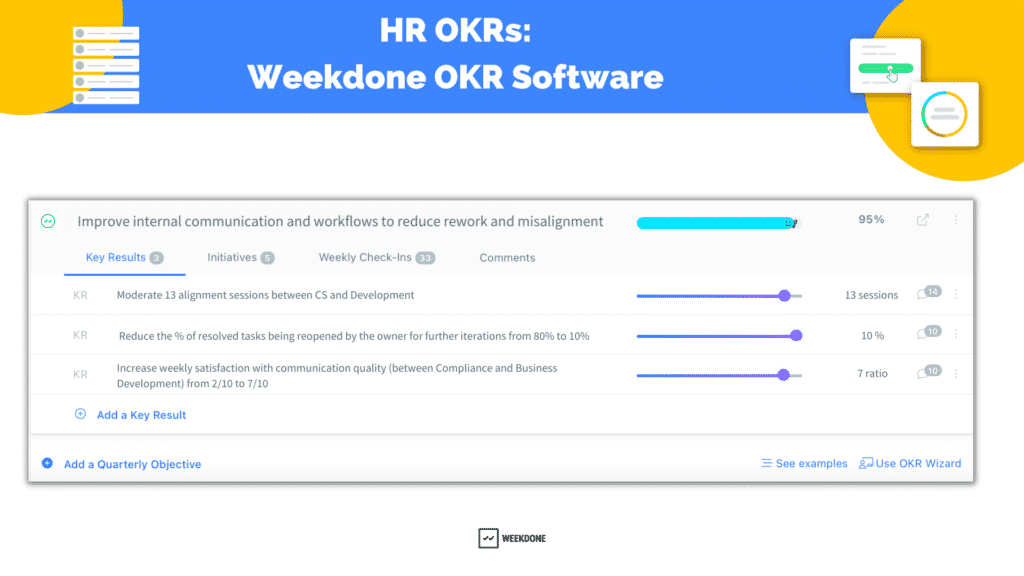
Writing Marketing OKRs
Marketers work under a lot of pressure. Competition is fierce, expectations are high, and it may take a lot longer than a quarter to see any impact on conversion numbers, ad ROI, and marketing strategy efficiency.
So how can quarterly OKRs help a marketing team keep their sanity and stay focused?
Step 1: Team Discussion
There are a few preparation steps the team needs to take to answer that question:
- Write down your learnings from the previous quarter, and try to make predictions for the future: what will work and what won’t (based on what worked before). Having a wrong hypothesis is better than having none at all.
- Look at your data, and understand which metrics are performing well and which ones might need attention. If you are not tracking your data, you need to fix that first. Take a course on Google Analytics, and learn how to read reports.
- Did you spot a lagging Key Performance Indicator? Any metrics that could use some improvement? In 99% cases the answer will always be “yes”.
- So, now, do you have any ideas on how to fix that?
A proper team discussion might take a week or two but you should put all of your ideas in writing, ask each other clarifying questions, and try to agree on a hypothesis that your entire team believes to be the most promising one.
Now let’s say, we’ve had a run at those questions, and here are the answers:
- When we were fixing the issues with reports in Google Analytics, we also noticed that our blog has a low visitor-to-signup conversion rate. Currently, it’s 4% less than the lowest industry average.
- We think that our potential clients are not likely to make decisions while reading our blog. So we need to understand their decision-making process better and provide answers to their questions. If our leads feel like we can anticipate their requests, they will be more likely to trust our expertise.
- This quarter, we’d like to focus on understanding our clients’ decision-making process, communicating our expertise through relevant software review websites (like Capterra), and building up our credibility online.
Step 2: Writing an Objective
When you are drafting an Objective, start by defining a problem you want to solve, and then try to phrase your highest impact idea.
Below is an Objective example to address the conclusions that came out of the marketing team discussion above.
Objective: Improve our presence on relevant review websites, forums, and groups to nurture leads with high buying intent
With this Objective, you will explore the websites and forums where decision-makers are asking questions and discussing the pros and cons of different tools/services. Your hypothesis is that by growing good reviews and active commenting, you can make your voice heard and showcase your expertise to potential new clients. Plus, you will understand your clients’ decision-making process much better.
Step 3: Writing Key Results
With the Objective focused on the review websites, forums and groups you start thinking:
Key Result 1
If we manage to start engaging discussions anywhere on the web, people should pick them up, and the volume of brand mentions would increase. This is how we will know if the angle we chose and the pitch we present are the right ones to spark interest.
Increase the number of positive brand mentions on the web from 3000 to 6000 (30-days average)
Key Result 2
Third-party reviews have more credibility than our own website messaging. We will try reaching out to our existing clients and asking them to publish reviews. We need to figure out how to motivate them better.
Increase the number of published reviews from 10 to 50 on Capterra
Key Result 3
This is the main outcome we should drive and our primary focus because generating discussions is useless without guiding potential clients to the next steps of the funnel.
Achieve 60+ demo requests from discussion forums & groups
Step 4: Writing Initiatives
To drive the progress on these OKRs, the team will need to consider which Initiatives they will prioritize and complete and how these Initiatives will link to the OKRs.
Initiatives might be:
- Create a list of potential websites, groups, and forums where we can start discussions
- Decide on 5-7 different pitch stories to connect with different audiences
- Create a new GA report to track conversion on the core pages
- Reach out to 100 good customers to ask for reviews
Step 5: Alignment & Linking
So this is how your final marketing OKR would look:
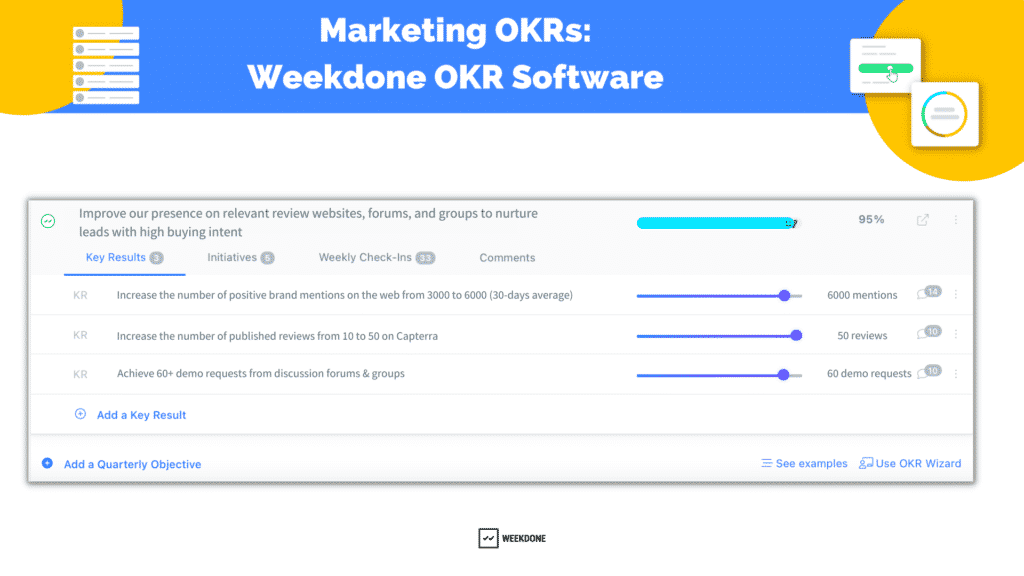
👀 Looking for more Marketing OKR examples? Add sample OKRs directly into your Weekdone account.
Writing Sales OKRs
Sales teams are considerably more data-driven than any other team in a company.
Which makes them better prepared to draft their Objectives and Key Results but also unexpectedly confused about the value of the OKR methodology.
Why does your sales team need a different goal structure if you already have your targets to hit? The answer is simple: you shouldn’t put your KPIs into your OKRs. Those two methods serve a different purpose but there is a clear connection between performance metrics (KPIs) and improvement goals (OKRs).
Step 1: Team Discussion
You will discuss KPIs and OKRs in the same conversation when you are looking into one of these 2 scenarios:
- You are falling behind on sales KPIs and you need an OKR to fix what’s broken and bring performance targets back on track
- You want to double/triple or 10x your growth, and you need an OKR to pursue something you haven’t tried before
In both scenarios, you are facing a gap between the current performance and the expected performance. Now, instead of constantly talking about the size of this gap, think how you would build the bridge over it:
- Are there any areas that seem to be broken or slow, and what can you improve about them?
- What has been working in the past, and can you double down on that effect?
- Or can the team come up with something totally new and achieve better results through innovation?
The answers to these questions will be the basis for your OKRs. Now let’s look at the sales OKR example.
Step 2: Writing an Objective
Potential customers seem to make it to our doorstep but they tend to drop off somewhere early in the sales process. Those who move on to later stages in the funnel, tend to buy. It means we are doing something wrong in the early stages. We know that our relationship with potential customers is crucial for their buying decision but we need to be better at building trust.
Objective: Improve the way we nurture relationships with potential customers at an early stage
Step 3: Writing Key Results
Key Result 1
Better relationship means more communication. Currently, we do not push enough for a second meeting and we need to work on that. This way we can get to know the customer better and vice versa.
Increase the number of second meetings booked from 10% to 40% on average
Key Result 2
We have many email templates that we use to communicate with potential customers. The response rate is really low. We need to work on having better email communication that engages customers.
Improve the email response rate from 5% to 10%
Key Result 3
We don’t really know what we are doing wrong at an early stage. Collecting feedback from lost deals will help us find new improvement areas and possible solutions.
At least 50% of lost deals reply to the “why not us” survey
Besides setting the OKR, the sales team should also think about the main things they can do to achieve the results above. Those ideas, projects, or plans are called Initiatives.
Step 4: Writing Initiatives
Based on the OKRs your sales team set up you’ll brainstorm Initiatives to get aligned on the KRs you want to drive:
- Develop a communication plan and introduce the structure to customers during the first meeting
- A/B test different messaging to see what works for our customers
- Set up “why not us” survey
Step 5: Alignment & Linking
So this is how your final sales OKR would look:
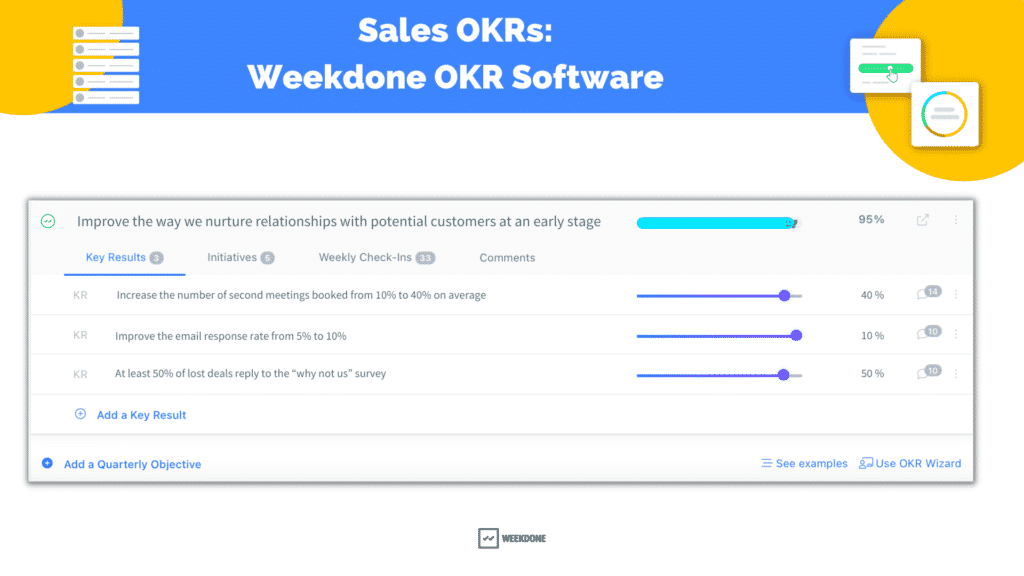
Simplify Writing OKRs Today
In conclusion, it’s safe to say that writing OKRs requires time dedicated from each team and individual. It’s more than a “set it and forget it” goal setting technique – its a framework to follow and track over time.
Ask the right questions, discuss with teams and be clear with your ideas and desired outcomes from step 1. Always consider the big picture and ensure everyone is connected to the company Objective.
Further, if you need guidance with the first quarter using OKRs, consider OKR software with expert consultations. Weekdone provides this and more in the software onboarding process.